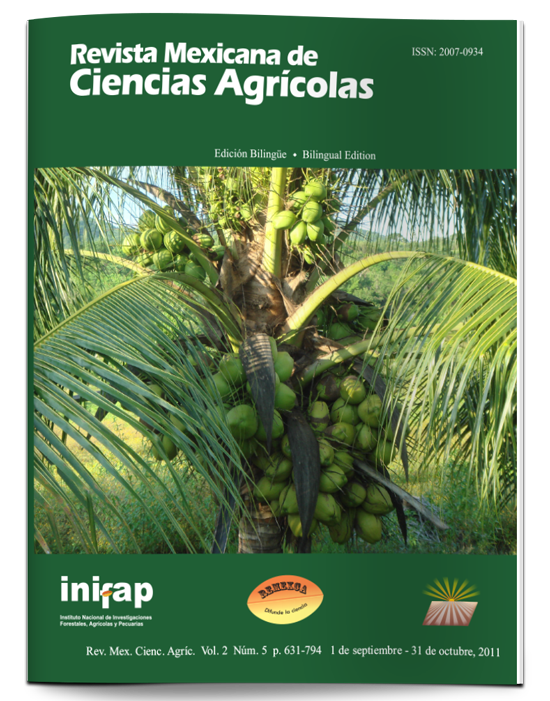FRUIT AND SEED DEVELOPMENT OF FIVE VARIETIES OF HUSK TOMATO IN SINALOA
DOI:
https://doi.org/10.29312/remexca.v2i5.1617Keywords:
Physalis ixocarpa Brot, planting dates, seed quality, yieldAbstract
Husk tomato has been cultivated in Sinaloa, Mexico, for 20 years and its importance increased in the last decade. There is little systematic information of management and productive potential of different varieties. The development of fruits and seeds and its quality, was studied on five varieties (Querétaro, Rendidora, Mahone, Orizaba, Carriceño) planted on two dates (PD1: September 6th and PD2: October 16th, 2008). Querétaro and Mahone varieties had on average, the longest fruit (37 and 34 cm), wider (43 and 40 cm) and heavier (38 and 34 g) respectively, this led the Querétaro variety to a higher (53 t ha-1) fruit yield (FrutY). The best crop development was observed in PD1, because PD2 presented a severe attack of powdery mildew (Podosphaera xanhtii), obtaining a FrutY 7.5 times lower. The growth kinetics of fruit’s weight was sigmoidal and showed that the peak was reached at 35 days after flowering (AF) (38 g). There were differences in the growth kinetics of a thousand seeds weight between the two PD; while in PD1, growth was linear, meaning that the maximum was not reached at 56 AF (last sampling); in PD2, growth reached a maximum at 42 AF (1.26 g). Similarly, the germination and seed vigor (first count in germination test) peaked at 56 AF (82% and 71% respectively).
Downloads
Downloads
Published
How to Cite
Issue
Section
License
The authors who publish in Revista Mexicana de Ciencias Agrícolas accept the following conditions:
In accordance with copyright laws, Revista Mexicana de Ciencias Agrícolas recognizes and respects the authors’ moral right and ownership of property rights which will be transferred to the journal for dissemination in open access. Invariably, all the authors have to sign a letter of transfer of property rights and of originality of the article to Instituto Nacional de Investigaciones Forestales, Agrícolas y Pecuarias (INIFAP) [National Institute of Forestry, Agricultural and Livestock Research]. The author(s) must pay a fee for the reception of articles before proceeding to editorial review.
All the texts published by Revista Mexicana de Ciencias Agrícolas —with no exception— are distributed under a Creative Commons License Attribution-NonCommercial 4.0 International (CC BY-NC 4.0), which allows third parties to use the publication as long as the work’s authorship and its first publication in this journal are mentioned.
The author(s) can enter into independent and additional contractual agreements for the nonexclusive distribution of the version of the article published in Revista Mexicana de Ciencias Agrícolas (for example include it into an institutional repository or publish it in a book) as long as it is clearly and explicitly indicated that the work was published for the first time in Revista Mexicana de Ciencias Agrícolas.
For all the above, the authors shall send the Letter-transfer of Property Rights for the first publication duly filled in and signed by the author(s). This form must be sent as a PDF file to: revista_atm@yahoo.com.mx; cienciasagricola@inifap.gob.mx; remexca2017@gmail.
This work is licensed under a Creative Commons Attribution-Noncommercial 4.0 International license.



